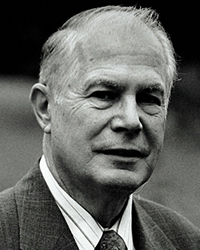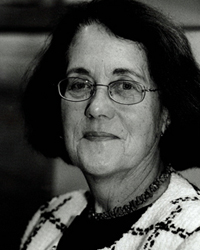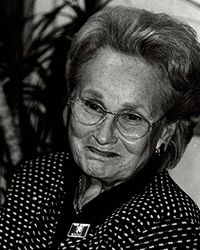Biography
Robert K. Wagemann
~ October 20, 2004
In 1937, while pregnant with Robert, his mother Lotte Wagemann was arrested due to her activities as on of Jehovah’s Witnesses and briefly incarcerated. She gave birth shortly after being released. Due to stress and limited prenatal care, the delivery was a breech birth, and Robert’s right hip was permanently damaged. His right leg is six inches shorter then the left.
Under the T4 Program, he was classified as handicapped, and twice targeted for extermination. The first time they escape to Berlin, and lived with relatives. The second time was 1943, when his mother was ordered to come with Robert to Schlierbach by Heidelberg to a hospital to be examined. The Nazi Doctor’s confirmed the status of his handicapped condition. During the examination, she overheard a conversation by the Doctor’s that he was to be classified as permanently handicapped, and would be given a lethal injection after lunch. When the Doctors left for lunch, she got Robert’s clothes, picked him up and fled.
Shortly there after their House in Mannheim was bombed and they went to Robert’s Grandparents (father side) to Iggelheim. First day of school Robert did not do the Hitler salute nor sing the national anthem (Deutschland, Deutschland ueber alles…) next day officials from the town came and wanted to pick him up. Due to the interference of his grandpa they left without him.
It was high time to move on, so they went to a town called Haardt by Neustadt a.d. Weinstrasse and lived with Robert’s grandparents (mother side). There in a little cabin in the woods they spent the remainder of the war.
The family survived the war, and in 1963, Robert immigrated with his wife Renate and two of their sons to the United States. They are now married for 45 years have threes sons and five grandchildren.
His mother is still living (going on 90), his father who was also blacklisted as a Jehovah’s Witness and sought after by the nazis, died in 1984.
Robert lives now with his wife Renate in Fairfield, NJ.
Bio of Robert K. Wagemann ~ October 20, 2004
The imprisoned Jehovah's Witnesses were given this document. By signing, they would be renouncing their faith and then released. Of all the Jehovah Witnesses imprisoned, only five out of approximately two-thousand signed the declaration and were released.
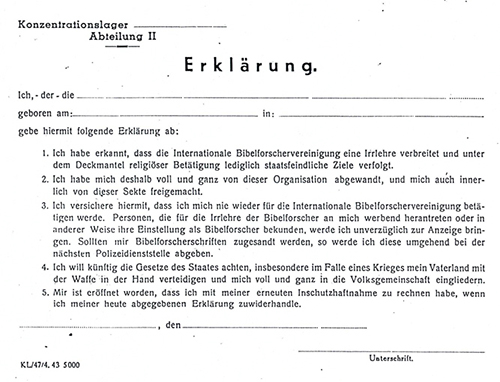
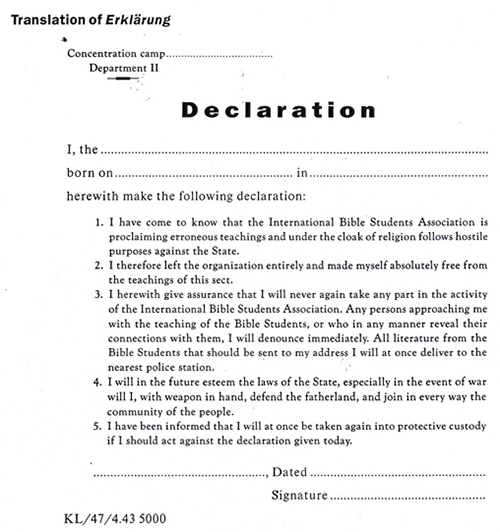
All Jewish females were required to use the middle name of "Sarah" on their passports. The males were required to use the name "Israel" There was a large "J" on the passport cover.
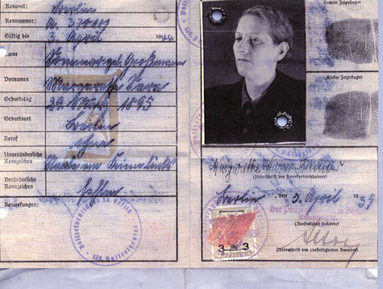
Himmler's Orders
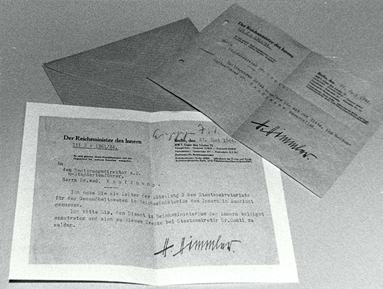
Mein Kampf by Adoph Hitler
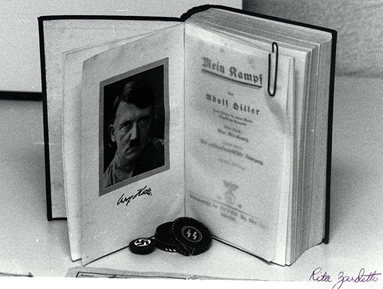
SS Lapel Pin with its orignial Box
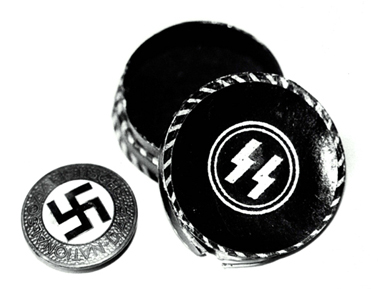
Biography
Ursula Lenneberg Pawel
Ursula was born on April 24, 1926 in Dormund, Germany as a daughter of a ‘mixed marriage’. Her father Otto was Jewish and her mother Caroline was Christian. Her mother converted to Judiasm in 1926. In 1925, Otto became a general manager of the Karstadt department store and her mother became the buyer for children and ladies’ clothing. They lived in a beautiful apartment and led a very nice life surrounded by many relatives. Ursula’s brother Walter was born in September of 1930.
In 1932, Ursula started school in Aplerbeck. Her life changed drastically when Hitler came to power in January of 1933 as Chancellor of Germany and immediately put changes into effect concerning the Jews. Jewish stores and businesses were boycotted and, by 1935, the Germans enacted the infamous Nuremberg Laws. These laws made anti-Semitism official policy and affected 500,000 Jews by depriving them of their German citizenship and placing all kinds of restrictions on them. One restriction forbade Jews to marry Gentiles. In 1934, Ursula was forced to leave her school and entered a Jewish elementary school in Dortmund. She had to travel a half hour by tram to get to school. Ursula was seven years when she experienced the hatred of anti-Semitism when two playmates told her that they could not play with her anymore because she was a Jew. As the result of the persecutions an boycotts, Ursula and her family were forced to move to Dusseldorf in 1936, the birth place of her father and where they had other relatives. Her father opened another dry goods business and Ursula attended a private Jewish school.
On November 9, 1938, her school and synagogue were burned. Kristallnacht (Night of the Broken Glass) changed her life even further. Jews had to adopt Sara and Israel in front of their names; identification papers were stamped with J for Jew in red and, eventually they were forced to wear a yellow star. By 1941-42, the State Secret Police (Gestapo) confiscated everything of value that Jews possessed. Her mother received an order to appear at the police station and was told to divorce her Jewish husband. She simply refused.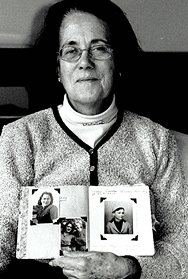
In July of 1942, Ursula received an order to present herself for deportation to a labor camp. Her family wanted to go with her. Her father Otto and brother Walter were able to join her. Each person brought a suitcase along with clothing that the Germans later confiscated for their own use. She was sent to Theresienstadt, Czechoslovakia, a labor camp situated in an old army fortress. This camp was a transit camp to Auschwitz, a death camp located in Poland. In Terezin, she became a youth leader of her block L414 and was placed in charge of teaching them. Her father was a talented carpenter and he managed to get extra rations for them. Her mother also arrange for her to receive packages, which she shared with her charges.
In the spring of 1944, Terezin was undergoing a “beautification” program because they were expecting the Red Cross to come to visit. A bank was opened and ghetto money was printed. Stores were opened, gardens were grown, a library was built and they even had a theater. Children were playing on the pavilion, a choir was singing; only healthy looking Jews were permitted outside. As soon as the Red Cross departed, most of the inmates were sent to gas chambers to die.
In Terezin, the Jews managed to run many cultural events for themselves. They had many talented artists, musicians, painters and professional who used their talents to boost the morale of the prisoners.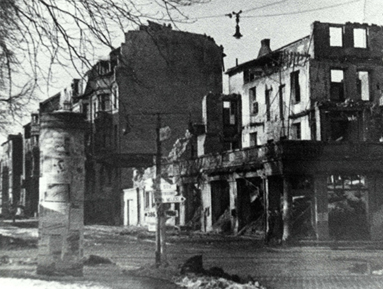 On September 30, 1944, her father and brother were shipped to Auschwitz and murdered in October of 1944. Ursula ended up in Camp c of Birkenau, which was part of the Auschwitz complex. The Germans shaved her head, stripped her of her clothes, and issued a prisoner’s suit – no underwear, no soap, and no towel or utensils. She was stripped of all human dignity. Chimneys were spewing out human ashes; a horrible smell permeated the air. She was eventually selected to do work and was put with non-Jews. There she met other girls and made life long friends.
On September 30, 1944, her father and brother were shipped to Auschwitz and murdered in October of 1944. Ursula ended up in Camp c of Birkenau, which was part of the Auschwitz complex. The Germans shaved her head, stripped her of her clothes, and issued a prisoner’s suit – no underwear, no soap, and no towel or utensils. She was stripped of all human dignity. Chimneys were spewing out human ashes; a horrible smell permeated the air. She was eventually selected to do work and was put with non-Jews. There she met other girls and made life long friends.
In the beginning of 1945, Ursula was sent to work in an airplane factory in Silseia. The forman did not like people with glasses and selected Ursula and three of her friends to be shipped back to Auschwitz. The transport was mostly filled with sick prisoners. One soldier put them in the last car and locked the door. Hours later, soldiers joined Ursula and her friends and gave them food. At the train station of Merzdorf/Riesengebirge, the soldiers told them to jump out and follow them. They were handed over to a factory where prisoners were mostly Polish and Hungarian Jews. This saved her life.
In May of 1945, they were liberated by the Russians. Ursula and Bushchi, her good friend from Holland and fellow camp survivor, made a 500-mile bike trek across Germany to a village near the Dutch border where her mother was staying. They traveled asking for shelter and food along the way. Most people responded with kindness. Germany, 1945After a struggle to leave Germany and, with the help of UNRRA (United Nations Relief and Rehabilitation Administration), American Joint Distribution (AJDC) and Hebrew Immigrant Aid Society (HIAS), she and her mother were able to obtain and affidavit and come to America in 1947. It was easier to come to America if you were a German citizen than a citizen of other countries because of the unfilled German quotas. With the help of AJDC, Ursula and her mother settled in Boston. Ursula was helped by a very kind and famous radiologist, Dr Alice Ettinger, Chief Radiologist in Pratt Diagnostic Hospital, and she became an x-ray technician.
Ursula met her husband Hans Pawel and they were married in 1948. Her mother remarried a week later to Siegmund Bruenell. Ursula and Hans have two children. Her husband Hans passed away in 1999. Ursula wrote a book about her experience, My Child is Back, published as part of Holocaust testimonies. She is very actively involved in telling the story of her teenage years and what happened during the Holocaust as a lesson for young people. Today Ursula lives in Bedminster, New Jersey.
SUGGESTED FURTHER READING
Kriskova et al. Secret Magazine of the Boys of Terezin. Jewish Publication Society. Teenage boys in Terezin publish a literary magazine. Grade 7 and up.
Ayer, Eleanor, Helen Waterford and Alfons Heck. Parallel Journeys. Helen and Alfons are born in close vicinity of each other. Helen ends up in a concentration camp and Alfons joins the Hitler Youth. Grade 7 and up.
Matas, Carol. Daniel’s Story. Daniel is a fictitious story based upon a compilation of photographs of children in Germany. 4th – 5th grades.
This is a small portion of the blanket that was issued to Ursula upon arriving at Merzdorf, a labor camp in Poland. At this time, she was assigned the number: 67269. After liberation in May 1945, Ursula and Buschi traveled 500 miles across Germany back to Lippborg. Since there was still fighting, they stitched Dutch flags onto their coats so they would not be arrested or bothered by troops. Also in this image are photos of Ursuala before and after her war experiences. 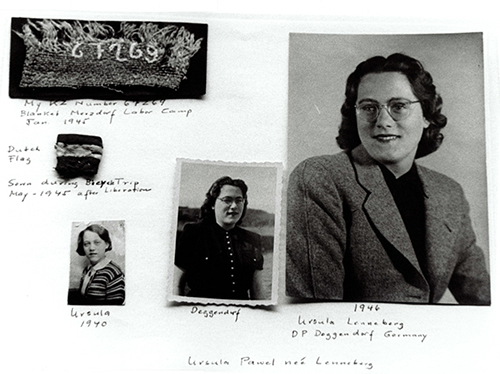
Ursula's Route Across Germany Post-Liberation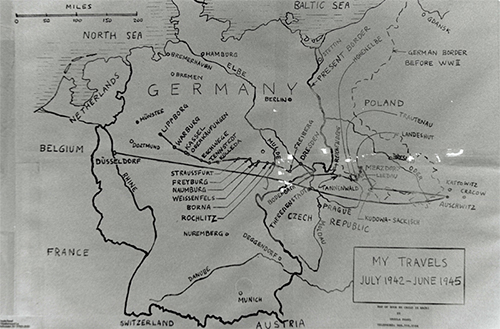
At Theresienstadt, a ghetto in Czechoslovakia, prisoners were forced to write postcards informing their relatives that they were fine and being treated well. This postcard was writted by Ursula's brother Walter, age 14, to his Uncle Erich.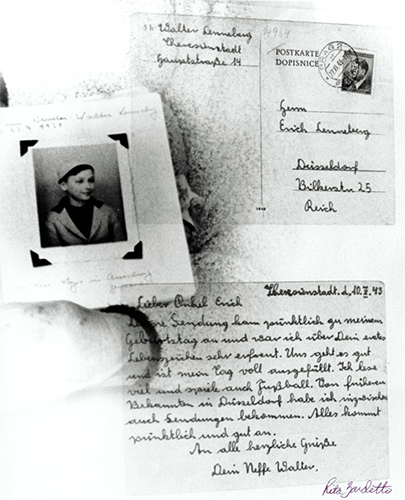
In Theresienstadt, this "fake" money was distributed during the "beautification" for a Red Cross visit in the Spring of 1944.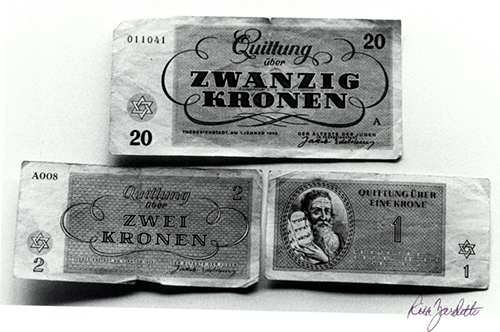
As Ursula rode her bike on hte 500 mile trip back to Lippborg after liberation in 1945, she began writing notes of her experiences. Upon arriving there, she transcribed her notes into this diary. It is her most prized possession.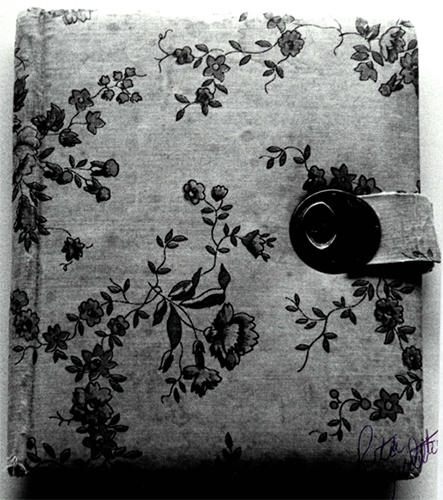
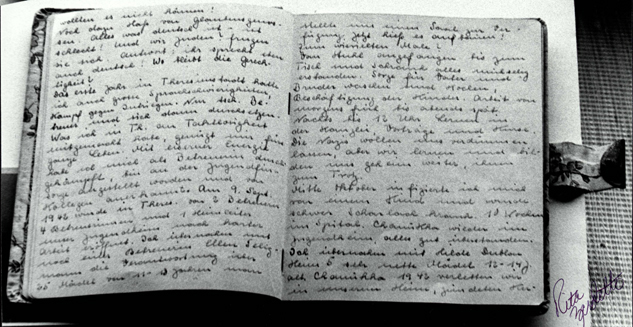
Biography
Margit Buchhalter Feldman
Margit, the only child of Joseph and Theresa Buchhalter was born in Hungary on June 12, 1929 in Budapest. Her parents had an orthodox home. They lived in Tolcsva near the Czechoslovakian border; a small agricultural town numbering about two thousand people with Jews making up one tenth of the population. Margit had fond memories of her early childhood and looked forward to the celebration of holidays and the Sabbath. Margit attended parochial school that was supported by the government. There were about sixty Jewish children in her town and they attended Jewish day-school. As a child, Margit was conscious of the prejudice against the Jews. Religious children dressed differently and suffered from discrimination by their non-Jewish peers. In 1941, Margit attended school in Budapest and lived with her relatives for a while. The Jews were already suffering from a set of discriminating laws that were implemented against them in the late 1930’s. Margit was brought home because her parents feared for her safety.
Margit’s father Joseph owned a general store and suffered from economic decline because he was forbidden to carry and sell certain merchandise such as sugar, coffee, flour and various oils. These products required coupons and Jews were not permitted to sell them. In the summer of 1943, her father and two uncles were ordered to report to an assigned location in order to be taken to a forced labor camp. While her father and uncles were away working on a farm, her mother Theresa ran the business and Margit helped with many of the chores. He was released shortly before the German occupation in March of 1944. The Arrow Cross, an extreme right-wing nationalistic Hungarian group started their own “Final Solution” of the Jews before Passover of 1944. 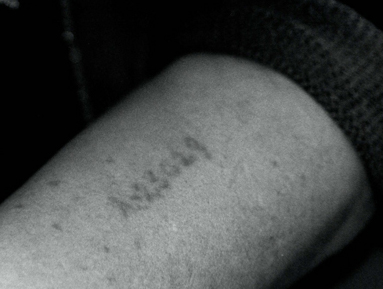
The Buchhalter family and many other Jews were imprisoned in a ghetto of Satoraljaujhely, a nearby town. From there Margit and her family were shipped to Auschwitz, a death camp in Poland. In Auschwitz Margit who was 15 years old lost her protective parents and clung to her aunts who survived the selections for death. She told the Nazis that she was eighteen and this made her eligible for forced labor. She was transferred to Crakow to work in a quarry for a little while and then sent back to Auschwitz. During her second stay in Auschwitz she became aware of the terrible experiments on twins that were being conducted by infamous Dr. Josef Mengele.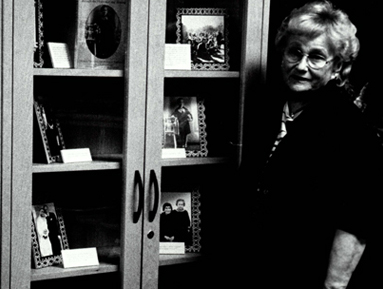 In early winter of 1944-45 she was shipped to work in a munitions factory in a camp called Grunberg, a subcamp of Gross Rosen in eastern Germany; that camp was not as harsh as Auschwitz. Margit and the prisoners had a little more food to eat. There she met Gerda Weiss Klein, a well known Holocaust survivor and writer. Margit was taken on a death march to Bergen Belsen. She was liberated on April 15, 1945 in Bergen Belsen by the British, a very sick young girl of sixteen, all alone and without family. She was injured by an explosive set by the Germans intending to destroy the camp and had pleurisy and pneumonia.
In early winter of 1944-45 she was shipped to work in a munitions factory in a camp called Grunberg, a subcamp of Gross Rosen in eastern Germany; that camp was not as harsh as Auschwitz. Margit and the prisoners had a little more food to eat. There she met Gerda Weiss Klein, a well known Holocaust survivor and writer. Margit was taken on a death march to Bergen Belsen. She was liberated on April 15, 1945 in Bergen Belsen by the British, a very sick young girl of sixteen, all alone and without family. She was injured by an explosive set by the Germans intending to destroy the camp and had pleurisy and pneumonia.
Margit was fortunate to be sent to Sweden to recover after the war and received kind treatment by the Swedish people. She found out that she had an aunt and uncle in the United States and joined them in August of 1947.
When Margit came to the United States she was still sick and it took her a number of years to recover. After she recovered she became an x-ray technician. This is when she met her Harvey Feldman, they were married in 1953 and have two children Tina and Joseph and three grandchildren, Caryn, Joshua and Zachary.
Margit has devoted her adult life to teaching children about the Holocaust and doing community work. She has dedicated herself to helping the powerless and vulnerable. The book: Margit- A Teenager’s Journey through the Holocaust and Beyond written by her and Bernard Weinstein has become recommended reading for children studying the Holocaust and distributed by the State of New Jersey Commission on Holocaust Education. Margit is a staunch supporter of Raritan Valley Community College Institute for Holocaust and Genocide Studies, and helps to create an annual spring program which three-thousand students attend each year to learn about the Holocaust and Genocide.
SUGGESTED RESOURCES
Holliday, Laurel ed Children of the Holocaust and World War II and Their Diaries-Grades 7-12 Covering all the countries that were involved during WWII
Atkinson, Linda. - In Kindling Flame: Story of Hannah Senesh- Grade 7-12- Telling of young Jewish Heroine who tried to help Hungarian Jews
Bierman, John - Righteous Gentiles: Story of Raoul Wallenberg, Missing Hero of the Holocaust- Grade 9-12 Detailed account how he saved thousand of Jews by issuing them Swedish passports.
Bitton-Jackson, Livia- Elli: Coming of Age in the Holocaust Grade 9-12- Tells story how she miraculously survived the war as a teenager
Bitton-Jackson, Livia- I have lived a Thousand Years: Growing Up In the Holocaust- Grade 5-10 A younger adaptation of the above book
Isaacson, Judith Magyar-The Seed of Sarah: Memoirs of a Survivor Grade 10-12 Joyful life in Hungary and then Auschwitz
Block, Gay and Malka Drucker- Rescuers: Portrait of Moral Courage in the Holocaust Grade 9-12 Forty nine people in many countries risked their lives to save Jews.
INTERNET SITES
- Council of Holocaust Educators
- great site for Educators
- United States Holocaust Museum, Washington, DC
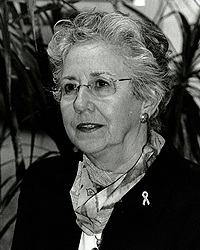 Biography
Biography
Maud Peper Dahme
Maud was born in Amersfoort, Holland on January 24, 1936, the daughter of Hartog and Lilly Peper. Her sister Rita was born on February 23, 1938. Her father Harry was a restauranteur and her mother Lilly a homemaker. The Germans invaded Holland in 1940; the Jews were relatively unmolested until the beginning of 1941, until the Germans set up Jewish Council. In the fall of 1941, all Jewish children were forced to leave public schools and study under the supervision of the Jewish Council. This affected Maud’s studies and she was forced to leave her school.
In July of 1942, German officials in Holland ordered all Jewish families to report to the train station with a single suitcase of their belongings which upon arrival to the camps was confiscated. Several thousand Jews were arrested and shipped to Westerbork, a camp in Holland. The next day a thousand were sent to Auschwitz. By October of 1942, 13,000 Jews were seized for shipment. Maud’s family was warned by a family friend who had ties to the underground of the upcoming arrests and shipments to camps and gave them the address of a safe house. Maud age 6 and her sister age 4 were separated from their parents and went into hiding. Her parents were helped in their town by another family. Righteous Rescuers who hid Jews took great personal risks and acted very courageously, if caught the consequences were very serious and even possible death.
Three years of hiding in Oldebroek and two families later Maud was reunited with her parents; she did not want to go home with them because she did not know them. The post-war years were very painful for Maud and her parents; they learned that all of their relatives had perished.
Maud and her family came to United States in 1950 to rebuild their lives. Maud recalls how she was placed in fourth grade as a fourteen year old girl. She and her sister Rita devised a system of learning English by attending the movies every day and staying all day all for the cost of a quarter; thereby she was able to jump to the seventh grade the following school year. She graduated high school with her peers. College was out of reach because of lack of money.
Maud has become a champion for children of migrant workers and is a member of the Interstate Migrant Education Council of New Jersey. She has dedicated the last twenty four years by serving on her local school board and presently she is in the 25th year as a member of the New Jersey State Board of Education where she has served as Vice President and President. As a victim of the Holocaust she has set out to ensure that today’s children will have a quality public education, something that she was not able to get during the war years.
Maud is a very active member of New Jersey Commission of Holocaust Education and plays an active role ensuring that the Holocaust not be forgotten by teaching students to accept differences through her story of survival. Speaking about her Holocaust experience is a recent activity. She visits many schools to teach young people what happens when a nation is stripped of their civil rights. When the Commission sponsors summer teacher seminars on the Holocaust and genocide with visitations to camp sites, Maud accompanies the educators on their learning trips by sharing her experiences as a young child in hiding and relating the courageous behavior of her rescuers.
She married Hank Dahme in 1957 and they had four children and nine grandchildren. Hank passed away in 2001.
SUGGESTED RESOURCES
Reiss, Johanna- The Upstairs Room- Grade 5-10 Tells the story of a Dutch Jewish girl that hides for 2 ½ years with a farmer
Reiss, Johanna- The Journey Back- Grade 5-10- Same young girl is reunited with her family in Holland after the war
Von der Rol, Ruud and Irann Verhoeven- Anne Frank Beyond the Diary: A Photographic Remembrance- Grade 5-12 Collection of known and unknown photographs of Anne Frank and her family
Gille, Elisabeth-Shadows of a Childhood: A Novel of War and Friendship- Grade 7-12, Hidden in the French countryside tells the experiences of her two sisters that were hidden in a Convent.
Moskin, Marietta - I am Rosemarie Grade 7-12 Born in Holland she is sent to Westerbork transit camp then to Bergen Belsen
Vos, Ida - Anna is Still Here Grade 5-10, 13 year old Anna is hidden in Nazi-occupied Holland
Adler, David - Hiding from the Nazis Grade 3-6 True story of Lore Baer who at the age of four was place with a Non-Jewish family in the Dutch countryside
Greenfield, Howard - The Hidden Children- Grade 4-10 Tells the story of many hidden children during World War II
Stein, Andre - Hidden Children: Forgotten Survivors of the Holocaust - Grade 10-12, Hidden children in Europe written for older children
INTERNET SITES
The Eugenic Times a Mandel Project by Amy Mogland
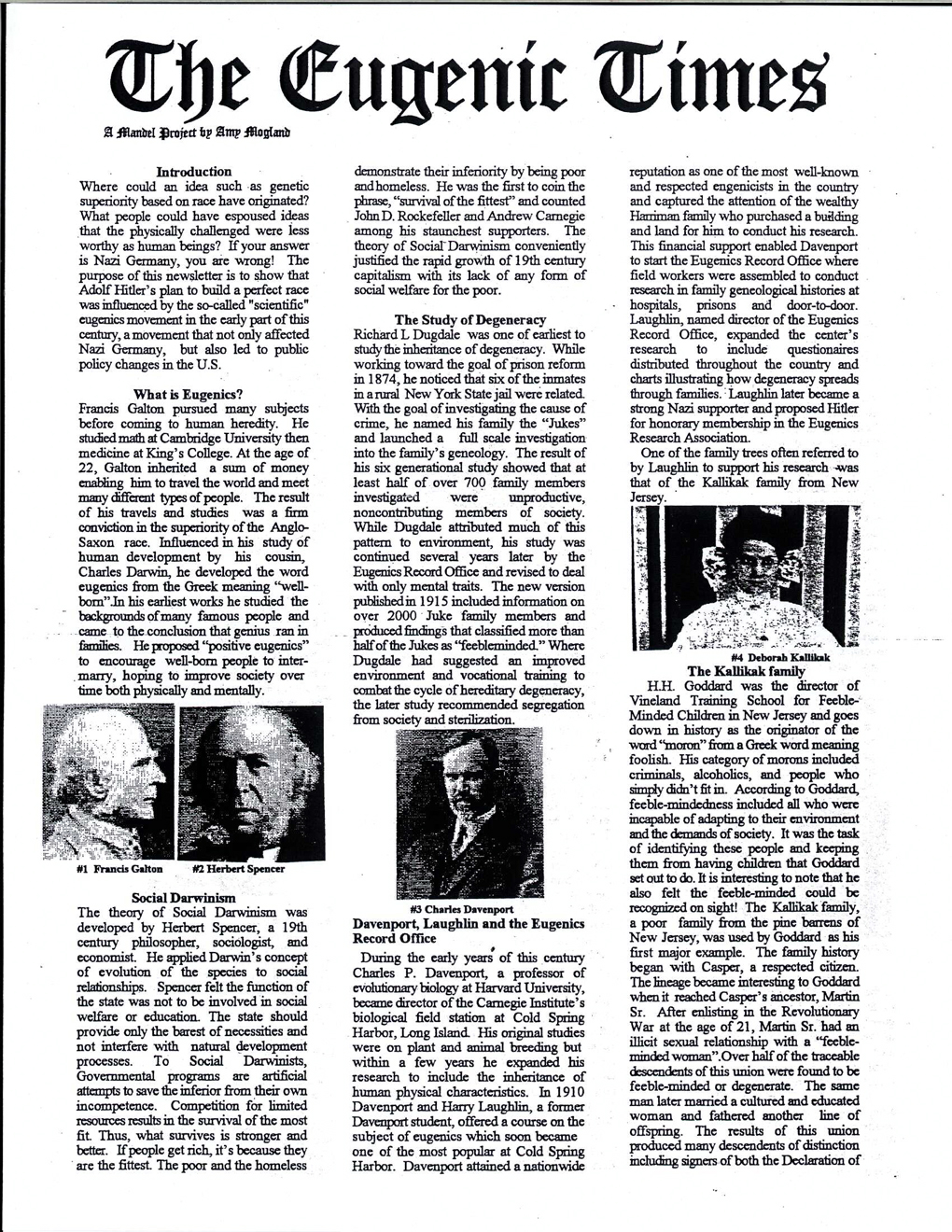
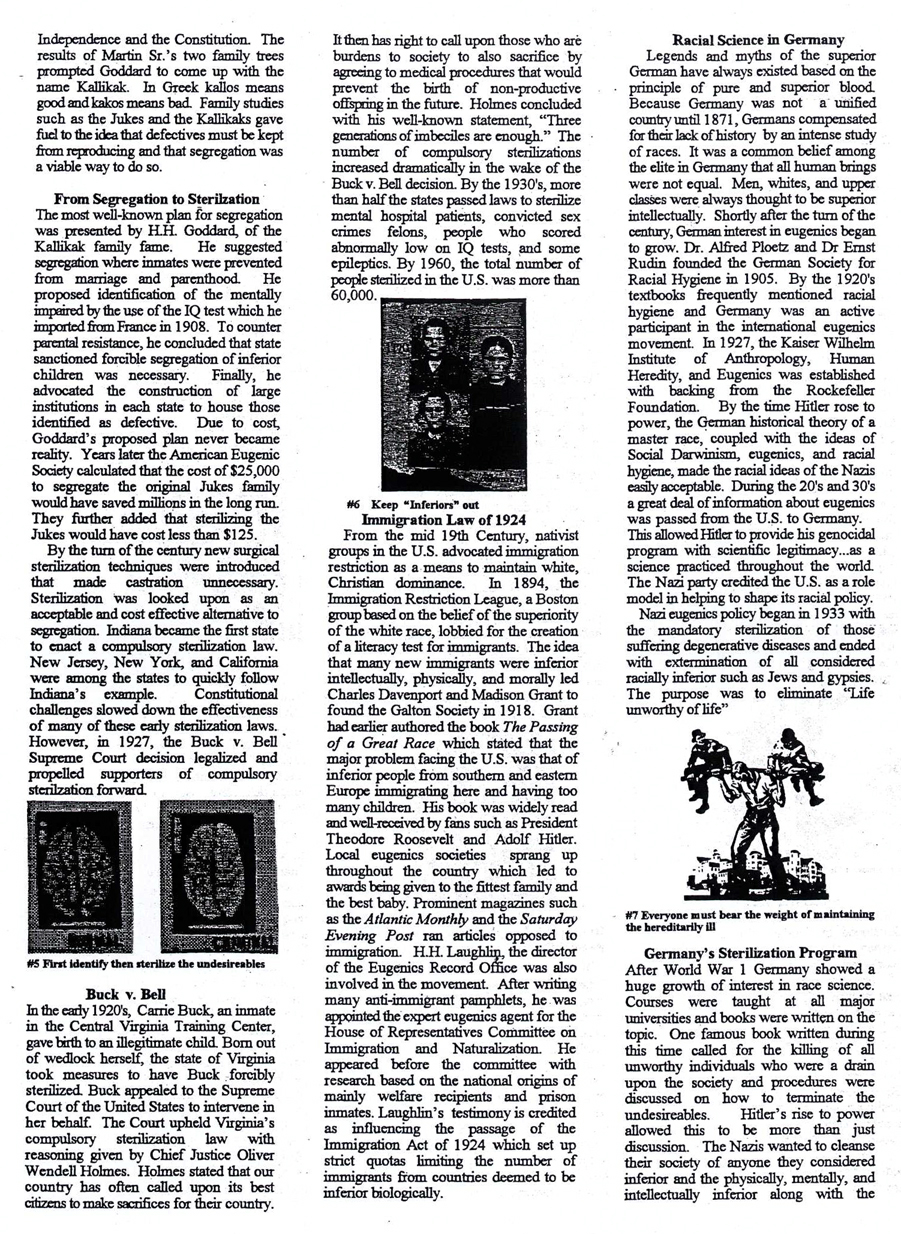
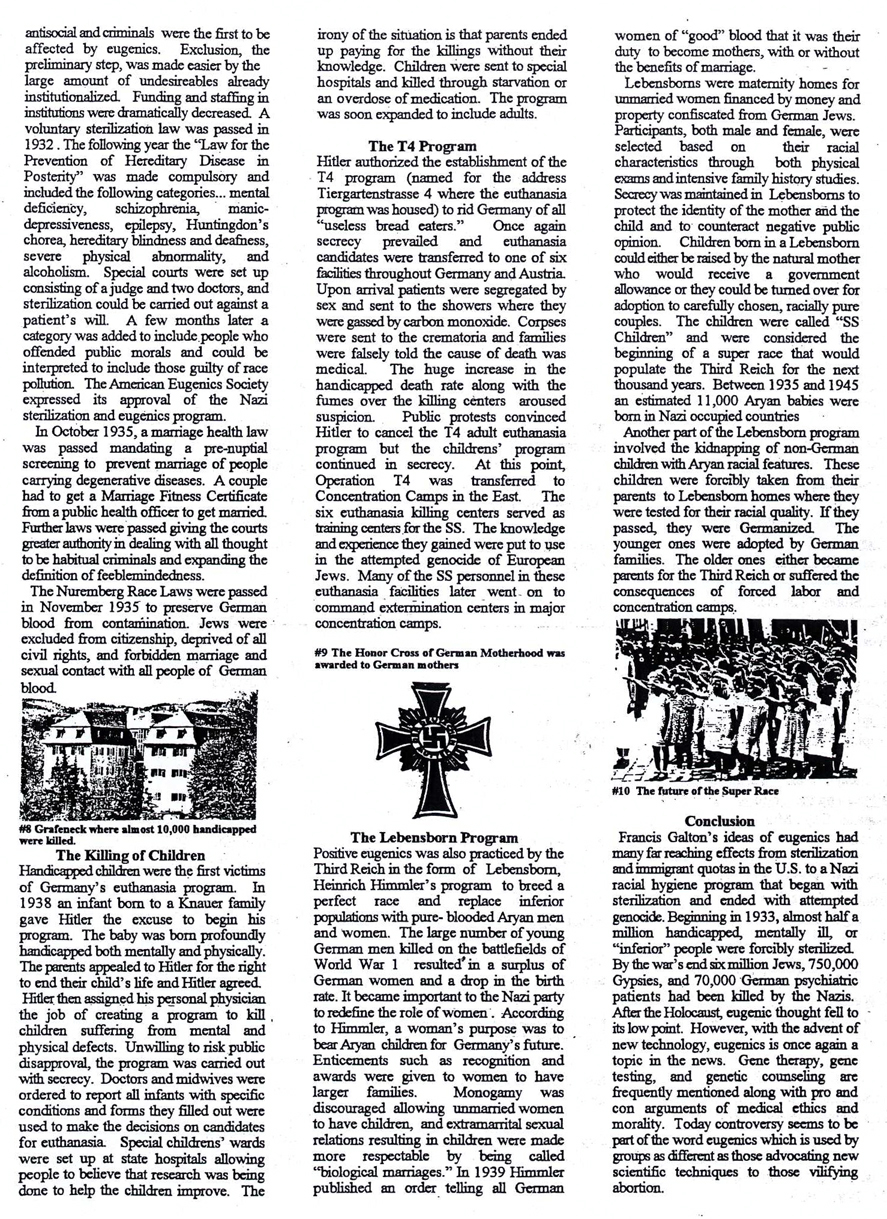
Genocide continues in the world today.
Pictured below is Yvette Rugasguhunga, who is a Rwandan genocide survivor, speaking about her experiences.
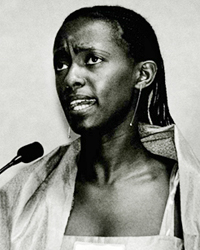
The Above Memorial Pages were created by:
Rita Danca Zardetto
Rita Danca Zardetto is from the Chicago area and has had a passion for photography since winning a Brownie camera in third grade. She has an Associate in Arts Degree from William Rainey Harper College in Palatine, IL and also attended the American Academy of Art in Chicago.
She worked for United Airlines for 18 years and moved to New Jersey in 1988. She quit her full-time job after the first of her two children was born. Rita has been taking several photography classes at RVCC, wanting to turn to photography as a second career.
Rita felt strongly about being part of this project, hoping to contribute in some way to the messages of the Holocaust survivors to future generations. It has been an insightful learning experience, and she will never forget the survivors who have touched her heart.
The Legacy Project
RVCC Service learning projects provide students with a number of unique opportunities. The Legacy Project is an outstanding example of how service learning student, Rita Zardetto, integrated her academic course work with service. Ms. Zardetto created the photo exhibit for the Legacy Project, as part of her studies in Commercial Photography II. The project enabled her to apply photography skills while learning about the Holocaust from the survivors who provided oral history interviews and artifacts. RVCC is very grateful for the contributions of Ms. Zardetto and the survivors who have made this project possible.

